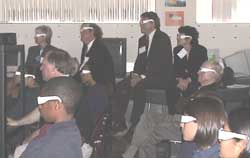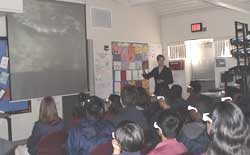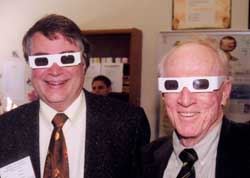Calit2 Brings Powerful Visualization Capabilities to Preuss School Students as part of OptIPuter Project
|
2.06.03 - "It's you kids who are on the cutting edge," said Calit² director Larry Smarr, addressing eighth-graders at the Preuss School in La Jolla. "I know, because my own kids are always saying to me, 'Dad, you're so Twentieth Century!"
Smarr was speaking at the dedication of a truly 21st Century teaching tool: a 3-D, large-screen visualization system that until now has only been deployed at universities. The Visualization Center at the Preuss School, a middle/high school on the UCSD campus, gives teachers and students a dynamic and engaging tool for teaching and learning in Earth sciences, biology, and other classes. The center will be linked to a high-performance information network that will permit students to interact with university faculty and graduate students and work collaboratively with them on research projects.
"This new center puts our school at the vanguard of new technologies that are reshaping and improving the way we teach, especially in the sciences," said Doris Alvarez, Principal of the Preuss School. "We are deploying this technology years before it will reach most high schools, and we expect that by engaging students early on in the excitement of research, it will inspire more students to go into math, engineering and science-related careers."
"If you think about this coupling between the UCSD campus and the Preuss School, that's a very important thing," said Fran Berman, Director of the San Diego Supercomputer Center (SDSC). "Preuss students are the 'point of the spear' for the next generation - these are the people who will advance science."
The Visualization Center is funded as part of the National Science Foundation's OptIPuter, a Calit²-led project awarded to UCSD and five other campuses in Fall 2002. The OptIPuter project brought together three technology institutions affiliated with UCSD that helped build the new Visualization Center: Calit² -- a partnership between UCSD and UC Irvine -- and the Visualization Center at the Scripps Institution of Oceanography. The initial subject matter on Earth sciences was designed by researchers at Scripps and the Geology Department of San Diego State University (SDSU).
The central feature of the Preuss Visualization Center is the GeoWall, a projection video system that allows the students to view high-resolution images in 3-D. Two separate projectors cast a bright stereo image onto a 7'x7' screen. People in the audience see a confusing double image -- until they look through the special 3-D glasses that the Preuss students wear, and then the view leaps into 3-D.
"This is very much like the Captain Eo setup at Disneyland," explained SDSC's Director of Visualization Mike Bailey, who designed the facility with Rozeanne Steckler, SDSC's Director of Education. "The computer graphics system sends two separate images, a left-eye view and a right-eye view, to two projectors simultaneously. Each projector has a polarizing filter in front of its lens, and the filters are oriented 90º apart. The students wear inexpensive stereo glasses with matching polarizing filters that allow each eye to see only one of the two images on the screen."
Unlike Captain Eo , the GeoWall is educational as well as visually impressive. At today's dedication ceremony, science teacher Jennifer Krummel and her students used the system for an introduction to Earth sciences, taking students on a tour of major geological and other Earth features with a 3-D fly-over.
|
"This sort of technology is the future of education," said Krummel. "My students and I are very excited that our school has the honor of being one of the first schools to put this technology into action. These students probably would not have access to this cutting-edge science in the schools they come from. I hope that this makes them more interested in science in general."
Today's session showed a flight around our planet that graphically illustrated facets of geography and geophysics. At Krummel's direction, the viewpoint pulled back until the Earth was only a tiny ball, and then zoomed forward toward several locations on the globe, displaying them at higher and higher resolution until incredibly fine details from aerial photography could be discerned in the synthetic images. Several children and adults watching the demonstration gasped aloud when an oblique view of the Himalayan Plateau suddenly exaggerated the heights of the mountains by a factor of 12, causing the entire region to bulge outward from the planet.
As she ended the demonstration, Krummel spun the Earth to North America, approached Southern California, and smoothly zoomed in until the individual buildings of Preuss School itself were visible on the screen.
"The equipment and software are state of the art," Bailey said, "and are based on things that we use in SDSC's VisLab," Bailey said. "Inside a high-end PC are two graphics systems -- a powerful NVIDIA 3D graphics card that accelerates the display of lines and polygons, and a TeraRecon VolumePro 1000 card that accelerates the display of volume-based data."
The visualization runs on a GeoFusion player that Bailey has developed for the Geosciences Network, a coalition of computer science and Earth science researchers who are linking and sharing multidisciplinary data sets to understand the complex dynamics of Earth systems. Preuss School classes will have access to hundreds of advanced software packages, including some that will be developed by SDSC, Calit², Scripps, and other UCSD units.
The center soon will be linked via fiber-optic network to the OptIPuter testbed, now under construction on the UCSD campus. The OptIPuter proposal included the Preuss School UCSD as a key testbed for its outreach and education strategy.
|
"The Preuss facility is powerful as a standalone educational tool, but, as part of the OptIPuter, it will provide a virtual-reality gateway to the world," said Calit² Director Larry Smarr, a professor of Computer Science and Engineering at UCSD's Jacobs School of Engineering and principal investigator on the OptIPuter project. "Eventually, students at the Preuss School will be able to interact in real time with images stored thousands of miles away -- everything from a fly-over of the surface of Mars to navigating deep inside a human cell."
The Preuss School is a public middle and high school (grades 6 through 12) dedicated to providing an intensive college preparatory education for low-income students who will become the first in their families to graduate from college. The school was named in recognition of a gift from Peter and Peggy Preuss, their son Peter, and the Preuss Family Foundation. Peter Preuss received his Master's degree in mathematics from UCSD in 1968 and went on to found Integrated Software Systems Corp. (ISSCO), a San Diego-based company that was then the first and only software firm specializing in computer graphics.
"It is gratifying that the Preuss School is now positioned at the forefront of this revolution that will harness high-performance computing and visualization for the benefit of education," said Preuss, who sold ISSCO in 1986 to Computer Associates. "This is a wonderful opportunity for students to get hands-on experience not only with today's technology, but with the technology of the future."
Researchers at SDSC, Scripps, and San Diego State University are working with teachers at the school to create a curriculum based on the new system's capabilities. "More than half of our PhDs in engineering in the U.S. are foreign nationals, and many now return home after receiving their education," said Scripps Deputy Director John Orcutt. "This technology will engender excitement in science, providing the Preuss School with a major opportunity to attract young people too often left behind."
"As technology evolves and as we get feedback from teachers and students, we will be continuously fine-tuning the system and building new software to keep it state of the art and to ensure that the technological innovation yields a faster, deeper learning experience in the classroom," SDSC's Bailey said.
The OptIPuter project has several other education projects in the planning stages. These include linking the newest undergraduate college at UCSD, Sixth College, to the OptIPuter testbed, enabling high-performance exploration of projects consistent with its theme of Culture, Art, and Technology. In suburban Chicago, the Lincoln elementary school, in collaboration with the University of Illinois at Chicago and its Electronic Visualization Laboratory, is developing plans for classroom-based science inquiry activities using remote data sets within the science domains featured in the OptIPuter proposal - geophysics and neuroscience.
Related Links
Photo Gallery
SIO Viz Center
SDSC
SDSU




